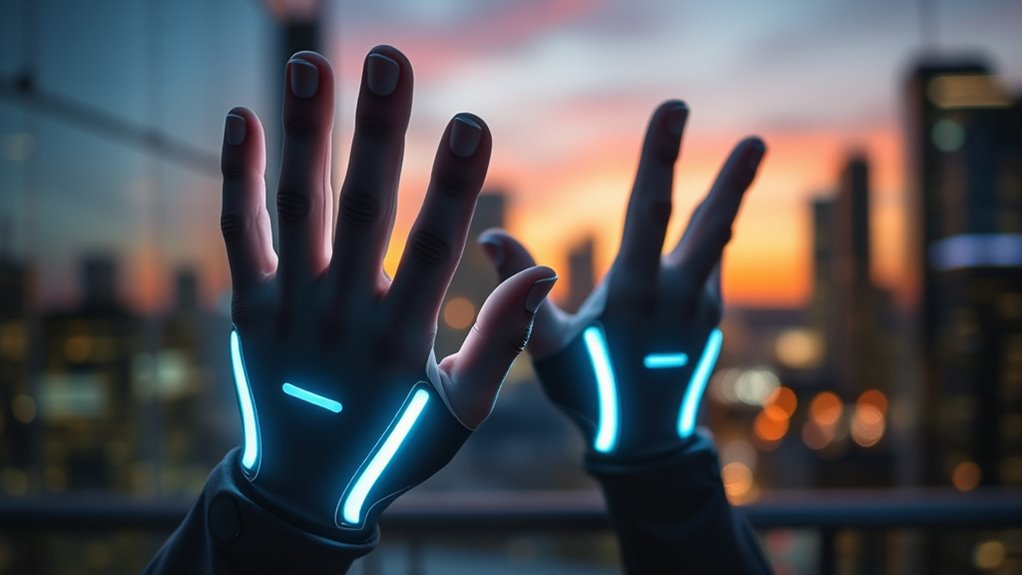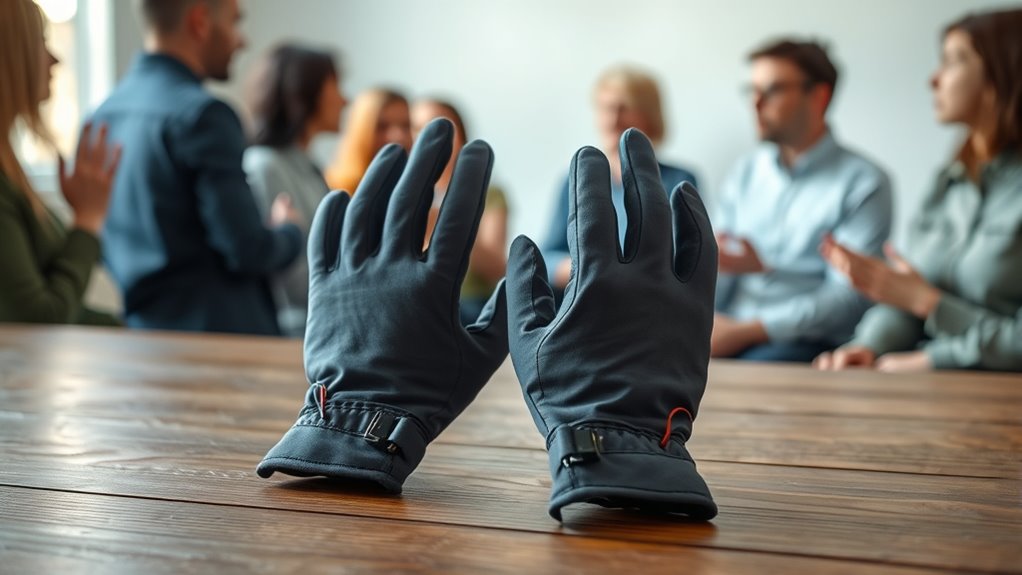Haptic ASL gloves hold real promise for transforming communication by combining gesture recognition with tactile feedback, helping deaf and hard-of-hearing users express themselves more confidently. While some hype exists, ongoing advancements in sensor accuracy and machine learning are making these gloves more reliable and natural. They can bridge visual and tactile communication modes, offering hope for greater inclusion. Curious about how this technology might evolve? Keep exploring to uncover the exciting future ahead.
Key Takeaways
- Advancements in gesture recognition and machine learning are enhancing the accuracy and reliability of haptic ASL gloves.
- Innovations in tactile feedback technology promise more realistic and varied sensations, improving user experience.
- Continued development aims to reduce false positives and make the gloves more seamless and intuitive to use.
- While hype exists, ongoing research indicates significant potential for improved communication accessibility.
- Practical challenges remain, but technological progress suggests a hopeful future for widespread adoption and impact.

Haptic ASL gloves are transforming how deaf and hard-of-hearing individuals communicate by providing real-time tactile feedback for sign language. These gloves leverage advanced gesture recognition technology to interpret your hand movements and translate them into meaningful signals. When you sign, sensors inside the gloves detect finger positions, hand orientation, and movement patterns with high accuracy. This data is then processed instantly, allowing the gloves to deliver tactile feedback directly to your skin. The tactile feedback acts as a form of haptic communication, giving you a physical cue that confirms your signing or indicates when a word or phrase is recognized correctly. This immediate sensory input bridges the gap between visual and tactile modes of communication, making sign language more accessible in noisy environments or situations where visual cues are limited.
The core strength of these gloves lies in their ability to combine gesture recognition with tactile feedback seamlessly. As you perform signs, the gloves continuously analyze your gestures, matching them against a database of sign language movements. When a sign is detected, they deliver a subtle yet noticeable tactile response—like a gentle tap or vibration—so you know your message has been correctly interpreted. This real-time interaction enhances your confidence while signing and reduces misunderstandings that can happen with traditional sign language translation tools. Furthermore, the tactile feedback can be customized, allowing you to adjust the intensity or type of sensation based on personal preference or environmental needs. This flexibility makes the gloves suitable for a wide range of users, from casual signers to professionals. Advances in gesture recognition technology and haptic feedback systems are expected to further improve their accuracy and user experience.
Looking ahead, the future of haptic ASL gloves hinges on continued improvements in gesture recognition algorithms and tactile feedback technology. As machine learning models become more sophisticated, you can expect even more precise recognition of complex signs, including facial expressions and nuanced finger movements. These advancements will make the gloves more intuitive and reliable, reducing false positives and enhancing their usefulness in daily communication. Additionally, innovations in haptic technology could offer more varied and realistic tactile sensations, further enriching the signing experience. While some skeptics view the hype around these gloves as premature, the potential benefits are undeniable. They offer a promising glimpse into a future where deaf and hard-of-hearing individuals can communicate more naturally and effortlessly, blending technology with human connection. For now, haptic ASL gloves represent a hopeful step toward greater accessibility and inclusion, but ongoing research and development will determine whether they fulfill that promise fully.
Frequently Asked Questions
How Affordable Will Haptic ASL Gloves Be for Everyday Users?
You wonder how affordable haptic ASL gloves will be for everyday users. Based on cost analysis and market accessibility, prices are expected to decrease as technology advances and production scales up. While initial costs might be high, increased competition and innovation should make these gloves more accessible over time. Ultimately, affordability will improve, making it easier for many people to benefit from this technology in daily communication.
Can Haptic Gloves Translate All ASL Signs Accurately?
You wonder if haptic gloves can accurately translate all sign language nuances. While advances improve recognition, perfect accuracy depends on precise glove calibration and understanding subtle movements. Complex signs with facial expressions or finger positioning may still challenge current tech. You’ll need gloves that adapt to individual signing styles, but ongoing improvements hold promise for more reliable translation, making communication smoother over time.
What Are the Main Technical Challenges Faced by Developers?
You’re tackling some delicate hurdles in developing haptic ASL gloves. The main technical challenges include perfecting sensor calibration, so signals are accurate and consistent, and reducing latency to make sign translation seamless. These issues, while complex, aren’t insurmountable. With dedicated effort, you can refine the technology to improve responsiveness and precision, bringing more reliable and natural communication tools closer to reality.
How Durable Are the Gloves for Long-Term Use?
You might wonder about the durability of these gloves for long-term use. Their material durability varies, but high-quality components tend to withstand regular wear. Keep in mind, maintenance requirements can influence longevity; proper care, like cleaning and avoiding harsh conditions, helps extend their lifespan. While some gloves are built for durability, ongoing usage may still lead to wear and tear, so regular checks and maintenance are essential.
Will These Gloves Work Across Different Languages and Sign Systems?
Think of these gloves as a universal translator for sign language. They could adapt to different languages and sign systems, but success depends on addressing linguistic diversity and cultural adaptation. You need to guarantee the technology recognizes unique gestures and nuances across cultures. While promising, it’s vital to refine these devices so they truly bridge language gaps, respecting each community’s linguistic and cultural identity.
Conclusion
While haptic ASL gloves hold exciting promise, don’t forget they’re still in development. Some experts believe they could revolutionize communication for the deaf community, but others argue the technology isn’t quite there yet. It’s tempting to see these gloves as a perfect solution, but real-world challenges like accuracy and affordability remain. So, while hope is justified, it’s wise to stay cautious—these gloves might be closer to hype than ultimate reality, at least for now.











